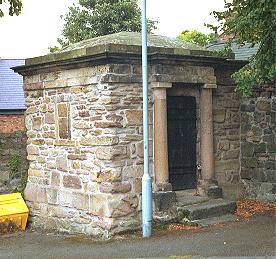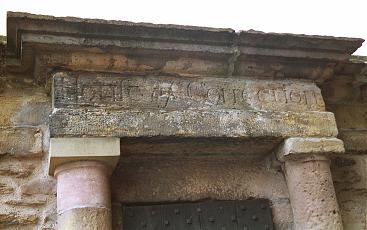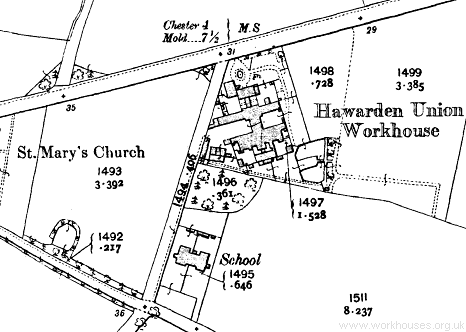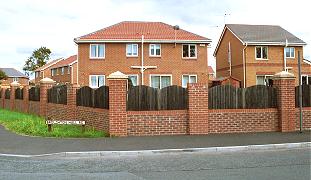Hawarden, Flintshire
Up to 1834
In March 1830, thirteen out of the fourteen townships in parish of Hawarden opened a workhouse in a former mansion, rented for the purpose at £50 a year, together with 22 acres of land, at £2 a year. The premises could accommodate 90 inmates. A report in 1834 decribed the institution as follows:
The official establishment consists of governor and matron, at a yearly salary, for both, of £40, and a surgeon, who receives £30 per annum for attending sick pauper parishioners, whether in or out of the house. In consequence of the contiguity of the church and national school, a separate chaplain and schoolmaster are not thought necessary. The principal regulations to prevent residence in the house being a matter of desire or indifference to the poor are, the prohibition of spirituous liquors, separation of the sexes by night, regularity in hours, and forced employment. The latter, as regards the able-bodied, consists in the cultivation of part of the land by means of spade husbandry; but the work is not by the piece. The governor, however, states that lie personally superintends the labourers; and as the number has always been small, probably he can do so with effect. Those who are incapable of laborious employment are set to pick oakum, and spin. The allowance of food is in no case proportioned to the work performed. The breakfasts and suppers consist of milk gruel, with seven ounces of wheaten bread for the men, (half an ounce less for the women,) and the dinners, of meat in some shape five times a week, with half-a-pint of beer to each daily. On Sundays the adults are restricted to six ounces of dressed meat at dinner; but there is no limit in quantity on the other days. A distinction is made in the treatment of the impotent and able-bodied, in favour of the former; those above 60, who have been accustomed to use tobacco or snuff, are each allowed weekly, half an ounce of the one or the other; and if females, a little tea and sugar is added, with a little butter, should their age exceed 70. The sleeping apartments of the sexes are effectually divided; but in the day, although a distinct room is appropriated to each sex, there is no separation beyond what thee individuals themselves may chose to maintain, the communication between the sitting-rooms being quite free, and the premises common to all for exercise. Pregnant single women, and mothers of illegitimate children, sleep by themselves, but associate in the day time with the other females, to the manifest injury of the young and virtuous, since, besides the risk of contamination, the circumstance of observing no difference made in the treatment of the profligate and the chaste, must tend to weaken in their minds the distinction between virtue and vice. livery one is required, if capable, to attend Divine service on Sunday; and the children are sent to the national school for about six or seven hours daily. This establishment performs the functions of a workhouse better than the incorporated house, which I attribute to the greater degree of vigilance exercised over it by the proper parochial. authorities, to its being more freely used as the medium of relief, and to its system of forced employment.
The aged and infirm, orphans, deserted children, bastards, pregnant single women, and able-bodied single men, are the classes usually sent to the house; married men and their children but seldom.
Hawarden also had an old "House of Correction", situated on Glynne Way . These institutions usually housed individuals found guilty offending against the vagrancy or poor relief laws. This one appears to have been a small "lock-up" where individuals could be held for arelatively short period.

Hawarden House of Correction, 2000.
© Peter Higginbotham.

Hawarden House of Correction, 2000.
© Peter Higginbotham
After 1834
Hawarden Poor Law Union officially came into being on 1st February, 1853, and encompassed the western part of the Great Boughton union which the Poor Law Board had decided covered too great an area. The new Hawarden union included parishes in Flintshire and, until 1871, Cheshire. Its operation was overseen by an elected Board of Guardians, 20 in number, representing its 15 constituent parishes as listed below (figures in brackets indicate numbers of Guardians if more than one):
County of Chester:
Doddleston, Eaton, Eccleston, Lower Kinnerton, Marlston-with-Leach, Poulton, Pulford, Great Saughall, Little Saughall, Shotwick, Shotwick Park, Woodbank.
County of Flint:
Hawarden (6), Higher Kinnerton, Saltney.
The population falling within the new union at the 1851 census had been 8,513 with parishes ranging in size from Shotwick Park (population 13) to Hawarden itself (5,349). The average annual poor-rate expenditure for the period 1850-52 had been £2,534 or 5s.11d. per head of the population.
The new union erected a workhouse in 1853-4 as a site to the north-east of Broughton. The building had an H-shaped structure with two parallel ranges running east-west connected by a short central block. The workhouse location and layout are shown on the 1911 map below.

Hawarden site, 1911.
In 1933, the premises were converted for use as an institution for 'mental defectives', later known as Broughton Hospital, which finally closed in 1994. The buildings have now been completely demolished and replaced by a housing estate.

Hawarden former workhouse site, 2000.
© Peter Higginbotham.
Staff
Inmates
Records
Note: many repositories impose a closure period of up to 100 years for records identifying individuals. Before travelling a long distance, always check that the records you want to consult will be available.
- North East Wales Archives (Hawarden), The Old Rectory, Rectory lane, Hawarden, Flintshire, CH5 3NR. Holdings include: Guardians' minute books (1857-1930, with gaps); Creed register (1914-21); Casuals' admissions and discharges (1916-32); Ledgers (1919-1930); etc.
Bibliography
- Phoenix, Rhona Life in the Hawarden Union Workhouse, Broughton 1855-1930 (2011)
Links
- None.
Unless otherwise indicated, this page () is copyright Peter Higginbotham. Contents may not be reproduced without permission.


